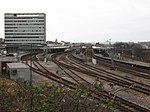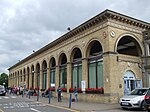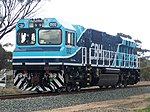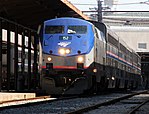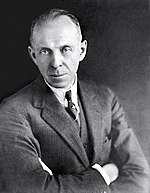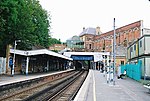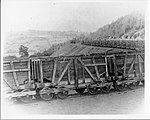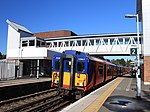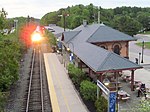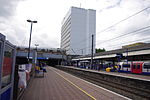This is an archive of article summaries that have appeared in the Selected article section of Portal:Trains in 2021. For past archives, see the complete archive page.
- Week 1
The Port of Napier announced an intention to reopen the section of line between Wairoa and the port from late 2017 due to a surge in forestry log traffic. In February 2018 the section was still mothballed and Minister for Regional Economic Development
Shane Jones announced the allocation of $5 million from the Provincial Development Fund to reopen it for forestry trains. The first train on the Napier-Wairoa line for six years ran from Napier to
Eskdale
Recently selected: Pacific Electric - Pacer (British Rail) - Overland Limited (UP train)
- Week 2
bus stop, allowing transfer to many routes.
Recently selected: Palmerston North–Gisborne Line - Pacific Electric - Pacer (British Rail)
- Week 3
cut-and-cover
excavation techniques. Since this method cannot be used under buildings, the route follows the streets above. It remains unchanged today and many original design features, such as the Nord-Sud company's refined ceramic decor, remain in the stations.
Recently selected: Paradis Station - Palmerston North–Gisborne Line - Pacific Electric
- Week 4
The .
Recently selected: Paris Métro Line 12 - Paradis Station - Palmerston North–Gisborne Line
- Week 5
Panel Signal Box at the station controls all trains between (but not at)
Totnes in Devon, and
Liskeard in
Cornwall
Recently selected: Penn Central Transportation Company - Paris Métro Line 12 - Paradis Station
- Week 6
The
European Road E6
.
Recently selected: Plymouth railway station - Penn Central Transportation Company - Paris Métro Line 12
- Week 7
The .
Recently selected: Polar Line - Plymouth railway station - Penn Central Transportation Company
- Week 8
The Tülomsaş has a manufacturing agreement with GE to produce PowerHaul locomotives for European, African and Middle-Eastern markets. The Tülomsaş plant produced its first PowerHaul locomotive in February 2011. In November 2011 Australian engineering firm
UGL Rail announced it was to develop a narrow gauge version of the class in association with GE. Three main subclasses exist:
PH37ACmi for UK railways, PH37ACi a version for mainland Europe and elsewhere built to UIC 505-1
vehicle gauge, and
PH37ACmai a version for
3 ft 6 in (
1,067 mm)
gauge lines. Versions of the locomotive include the
Class 70 used by Freightliner (UK), the
DE36000 of the
Turkish State Railways
Recently selected: Portland Streetcar - Polar Line - Plymouth railway station
- Week 9
Civil Rights Movement
.
Recently selected: GE PowerHaul - Portland Streetcar - Polar Line
- Week 10
Glasgow splitting at
Carstairs. Five London-bound portions depart from these destinations each night, combining into two trains at Edinburgh and Carstairs. Since April 2015, the
Caledonian Sleeper has been a standalone franchise operated by
Serco, and under the supervision of the
Scottish Government. Prior to this it was part of the
ScotRail franchise. In 2019 a new fleet of
Mark 5
Recently selected: Pullman porter - GE PowerHaul - Portland Streetcar
- Week 11
The Redwood forests along Pudding Creek and the
Noyo River. Along the way, the tracks cross some 30 bridges and trestles and pass through two deep mountain tunnels. The halfway point of
Northspur
Recently selected: Caledonian Sleeper - Pullman porter - GE PowerHaul
- Week 12
. It is the thirteenth busiest station in the UK outside London.
Recently selected: California Western Railroad - Caledonian Sleeper - Pullman porter
- Week 13
John Work Garrett (1820–1884). The station and its environs were also the site of several infamous civil strife actions of the 19th century with the
Baltimore riot of 1861, on April 18–19, also known as the Pratt Street Riots and later labor strife in the
Great Railroad Strike of 1877
Recently selected: Cambridge railway station - California Western Railroad - Caledonian Sleeper
- Week 14
The .
Recently selected: Camden Station - Cambridge railway station - California Western Railroad
- Week 15
The Cape Town Railway and Dock Company and then of the
Cape Government Railways. Possibly in early 1874, by then on the roster of the Cape Government Railways, this locomotive was rebuilt to a 0-4-2T configuration, before it was shipped to
Port Alfred where it served as harbour construction locomotive on the banks of the Kowie River. While serving at Port Alfred, it was nicknamed
Blackie. The locomotive has been declared a
heritage object
Recently selected: Canton Viaduct - Camden Station - Cambridge railway station
- Week 16
.
Recently selected: Cape Town Railway & Dock 0-4-0T - Canton Viaduct - Camden Station
- Week 17
The Watco WA Rail under a long-term contract, link various CBH grain collection points in the
wheatbelt with CBH terminal and port facilities in
Albany,
Geraldton and
Kwinana. The 25 members of the CBH class are divided into three sub-classes, based on differences in power output, traction motors and
track gauge
Recently selected: Cardiff Central railway station - Cape Town Railway & Dock 0-4-0T - Canton Viaduct
- Week 18
The former standard gauge line duplicated the southern section from Port Augusta to Maree in 1957 on a new nearby alignment. The entire Central Australia Railway was superseded in 1980 after the standard gauge Tarcoola–Alice Springs Railway was opened, using a new route up to 200 km to the west. A small southern section of the original line between Port Augusta and
Quorn has been preserved as the
Pichi Richi Tourist Railway
Recently selected: CBH class - Cardiff Central railway station - Cape Town Railway & Dock 0-4-0T
- Week 19
Lenox Avenue at the southern edge of
Harlem,
Manhattan. It is served by the
2 and
3 trains at all times. The station was constructed for the
Interborough Rapid Transit Company (IRT) as part of the
city's first subway line, which was approved in 1900. Construction on the tunnel to the south of 110th Street started on August 30, and construction on the tunnel to the north started on October 2 of the same year. The station opened on November 23, 1904. The station's platform was lengthened in 1910. The station contains one
island platform
Recently selected: Central Australia Railway - CBH class - Cardiff Central railway station
- Week 20
- The selected article has not yet been chosen for this week
Recently selected: Central Park North–110th Street station - Central Australia Railway - CBH class
- Week 21

Charing Cross is a London Underground station at Charing Cross in the City of Westminster. The station is served by the Bakerloo and Northern lines and provides an interchange with Charing Cross mainline station. Charing Cross was originally two separate stations, known for most of their existence as Trafalgar Square and Strand. The Bakerloo line platforms were opened by the Baker Street and Waterloo Railway in 1906 and the Northern line platforms by the Charing Cross, Euston and Hampstead Railway in 1907. In the 1970s, in preparation for the opening of the Jubilee line, the two earlier stations were connected together with new below ground passageways. When the Jubilee line platforms opened in 1979, the combined station was given the current name. Jubilee line services ended in 1999 when the line was extended to Stratford. The station is close to the National Gallery, the National Portrait Gallery, Admiralty Arch, St Martin-in-the-Fields, Canada House, South Africa House, the Savoy Hotel, The Mall, Northumberland Avenue and Whitehall.
Recently selected: - Central Park North–110th Street station - Central Australia Railway
- Week 22
Secunderabad
were awarded 183 points out of a maximum of 300 for cleanliness, the highest in the country.
Recently selected: Charing Cross tube station - - Central Park North–110th Street station
- Week 23
Italianate frontage was designed by the architect
Francis Thompson. Work on a £10 million regeneration scheme, the Chester Renaissance programme, was completed in 2007. The development includes a new roof, improved customer facilities and improved access to the station. A plaque commemorating
Thomas Brassey is installed on the wall opposite the booking office. The station marks one end of the
Baker Way a footpath leading to
Delamere railway station
Recently selected: Chennai Central railway station - Charing Cross tube station -
- Week 24
, and more within the station or within walking distance.
Recently selected: Chester railway station - Chennai Central railway station - Charing Cross tube station
- Week 25
The Kansas City, and
Denver. Because of this extensive trackage in the midwest and mountain states, the railroad used the advertising slogans "Everywhere West", "Way of the
Zephyrs", and "The Way West". In 1967, it reported 19,565 million net ton-miles of revenue freight and 723 million passenger miles; corresponding totals for C&S were 1,100 and 10 and for FW&D were 1,466 and 13. At the end of the year, CB&Q operated 8,538 route-miles, C&S operated 708, and FW&D operated 1362 (these totals may or may not include the former
Burlington-Rock Island Railroad). In 1970, it merged with the
Northern Pacific Railway and the
Great Northern Railway to form the
Burlington Northern Railroad
Recently selected: Chicago Union Station - Chester railway station - Chennai Central railway station
- Week 26
The trillion, commenced in 2014. The start date of commercial service is unknown, after
Shizuoka Prefecture
Recently selected: Chicago, Burlington and Quincy Railroad - Chicago Union Station - Chester railway station
- Week 27
The medium capacity line in Singapore, with each Circle Line train, the
C830 and
C830C
Recently selected: Chūō Shinkansen - Chicago, Burlington and Quincy Railroad - Chicago Union Station
- Week 28
The .
Recently selected:
- Week 29
Sir Federal Government in World War II, he played a pivotal role in the manufacture of fighter aircraft in the defence of Australia. As Director-General of Australia's Land Transport Board, he presented a report on railway gauge standardisation that ultimately led to the eventual linking of all Australian mainland capital cities by a uniform
track gauge
Recently selected:
- Week 30

The Cleveland and Mahoning Valley Railroad (C&MV) was a shortline railroad operating in the state of Ohio in the United States. Originally known as the Cleveland and Mahoning Railroad (C&M), it was chartered in 1848. Construction of the line began in 1853 and was completed in 1857. After an 1872 merger with two small railroads, the corporate name was changed to Cleveland and Mahoning Valley Railroad. The railroad leased itself to the Atlantic and Great Western Railway in 1863. The C&MV suffered financial instability, and in 1880 its stock was sold to a company based in London in the United Kingdom. A series of leases and ownership changes left the C&MV in the hands of the Erie Railroad in 1896. The CM&V's corporate identity ended in 1942 after the Erie Railroad completed purchasing the railroad's outstanding stock from the British investors. A number of ownership changes since 1942 have left the track in various corporate hands. Portions of the track are now biking and hiking trails.
Recently selected:
Circle MRT Line
- Week 31
The Provincial Growth Fund, to provide year-round service and to upgrade the Kaikoura, Blenheim and Picton stations. The service was again suspended on 23 March 2020 due to
COVID-19
Recently selected: Cleveland and Mahoning Valley Railroad - Harold Winthrop Clapp - City of New Orleans (train)
- Week 32
The of the metro, allowing 24 trains per hour in each direction west of Stortinget, and 28 east of Stortinget.
Recently selected: Coastal Pacific - Cleveland and Mahoning Valley Railroad - Harold Winthrop Clapp
- Week 33
and Norden but only certain services continue to Wareham.
Recently selected: Common Tunnel - Coastal Pacific - Cleveland and Mahoning Valley Railroad
- Week 34
The Ratgoed and quarries along the length of the Dulas Valley. The railway closed in 1948, but a preservation society was formed in 1966, initially opening a museum; a short section of line between Corris and
Maespoeth was re-opened to passengers in 2002. The railway now operates as a
tourist attraction. A new steam locomotive was built for the railway, which was delivered in 2005. The two surviving locomotives, plus some of the original rolling stock, are preserved on the nearby
Talyllyn Railway. The
gauge of the railway is
2 ft 3 in (
686 mm) which is unusual, and was shared by only three other public railways in the United Kingdom: the Talyllyn Railway, the short-lived
Plynlimon and Hafan Tramway and the
Campbeltown and Machrihanish Light Railway
Recently selected: Corfe Castle railway station - Common Tunnel - Coastal Pacific
- Week 35
East London Line
of the London Overground. This has been the catalyst for plans for a substantial redevelopment of the station.
Recently selected: Corris Railway - Corfe Castle railway station - Common Tunnel
- Week 36
The Penn Central, closed all railway facilities in Chambersburg in 1972 and its successor,
Conrail
Recently selected: Crystal Palace railway station - Corris Railway - Corfe Castle railway station
- Week 37
A predecessor to the Class I
Summit Hill and Mauch Chunk Railroad
(e. 1827) pre-dated its beginning of operations.
Recently selected: Cumberland Valley Railroad - Crystal Palace railway station - Corris Railway
- Week 38
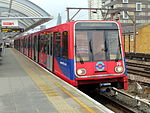
The Docklands Light Railway (DLR) is an automated light metro system serving the redeveloped Docklands area of London, England. First opened on 31 August 1987, the DLR has been extended multiple times, and now reaches north to Stratford, south to Lewisham, west to Tower Gateway and Bank in the City of London financial district, and east to Beckton, London City Airport and Woolwich Arsenal. Further extensions are under consideration. Normal operations are automated, so there is minimal staffing on the 149 trains (which have no cabs) and at major interchange stations; the four below-ground stations are staffed, to comply with underground station health and safety regulations. The DLR is owned by Docklands Light Railway Ltd, part of the London Rail division of Transport for London (TfL). It is operated under a franchise awarded by TfL to KeolisAmey Docklands, a joint venture between transport operator Keolis and infrastructure specialists Amey plc, having been run previously (1997–2014) by Serco Docklands. Passenger numbers have greatly increased as the network has expanded, and in the financial year 2019/20 there were 116.8 million passenger journeys.
Recently selected: Delaware and Hudson Gravity Railroad - Cumberland Valley Railroad - Crystal Palace railway station
- Week 39
South Western Railway
. It has three platforms, numbered 1–3 from left to right when looking towards London; each platform is long enough to accommodate 10 carriages. The platforms are connected by both a subway and a footbridge, with lift access available to all platforms.
Recently selected: Docklands Light Railway - Delaware and Hudson Gravity Railroad - Cumberland Valley Railroad
- Week 40
The is also being planned and set to open in the 2030s. When fully completed in 2025, the line will be about 44 kilometres (27 mi) long with 37 stations, and will serve more than half a million commuters daily.
Recently selected: Dorking railway station - Docklands Light Railway - Delaware and Hudson Gravity Railroad
- Week 41
Dublin Lockout
, which caused major distress within the city. Elements of the system went out of service from the mid-1920s, in part overtaken by the bus. The decline of the trams accelerated in the 1940s and the last trams ran on 9 July 1949 in Dublin city and in 1959 on Howth Head, near Dublin.
Recently selected: Downtown MRT line - Dorking railway station - Docklands Light Railway
- Week 42
Dunellen is an NJ Transit railroad station on the Raritan Valley Line, in Dunellen, New Jersey. It is the only Raritan Valley Line station in Middlesex County. There is a ticket office and small waiting area at this stop. A simple station, there are two tracks with two small side platforms. The station is located on a high embankment. Trains stop serving the station at midnight and resume by 5 in the morning. Automatic ticket vending machines have been installed along with an automated voice telling commuters when their train will arrive.
Recently selected: Dublin tramways - Downtown MRT line - Dorking railway station
- Week 43
Durham–University of New Hampshire station, also known as Durham–UNH station or simply Durham station, is a passenger rail station in Durham, New Hampshire, served by Amtrak's Downeaster line. The historic depot, which now houses the UNH Dairy Bar, is situated just west of downtown Durham on the campus of the University of New Hampshire (UNH). The station is owned by the university, but an adjacent parking area is managed by the town of Durham. On average, about 161 rail passengers board or detrain daily at Durham, making it the third-busiest Amtrak stop in New Hampshire.
Recently selected: Dunellen station - Dublin tramways - Downtown MRT line
- Week 44
The Dandenong works of
Bombardier, with the propulsion systems and bogies coming from Bombardier factories in Germany. The E-class is part of the Tram Procurement Program, a
Public Transport Victoria project aimed at increasing capacity and reliability of the tram network through the introduction of new trams, creation of new depot space, and upgrades to existing infrastructure. In September 2010, 50 were ordered with an option to purchase a further 100. In May 2015, a further 20 were ordered, followed by additional orders for 10 in May 2017, September 2018 and May 2019, taking the total to 100. The first tram was delivered in June 2013 and, after testing, entered service on
route 96 on 4 November 2013. As of November 2020
[update]
Recently selected: Durham–UNH station - Dunellen station - Dublin tramways
- Week 45
project, with a rebuilt ticket hall and the provision of step free access.
Recently selected: E-class Melbourne tram - Durham–UNH station - Dunellen station
- Week 46
The first regularly operated
Brooklyn Bridge–City Hall and 96th Street, allowing for local and express service. Planning for the subway started in 1894 with the enactment of the Rapid Transit Act. The plans were drawn up by a team of engineers led by
William Barclay Parsons, chief engineer of the Rapid Transit Commission.
Heins & LaFarge designed elaborate decorative elements for the early system. The city government started construction on the first IRT subway in 1900, leasing it to the IRT for operation under Contracts 1 and 2. After the initial line was opened, several modifications and extensions were made in the 1900s and 1910s. In 1918, a new "H" system was placed in service as part of the
Dual Contracts, splitting the original line into several segments. Most of the original IRT remains intact and operates as part of the
New York City Subway; however, several stations were subsequently closed.
Recently selected: Ealing Broadway station - E-class Melbourne tram - Durham–UNH station
- Week 47
The .
Recently selected: early history of the IRT subway - Ealing Broadway station - E-class Melbourne tram
- Week 48
The . Originally intended to enter revenue service in spring 2016, the first trains entered service on 23 December 2017.
Recently selected: East Anglia franchise - early history of the IRT subway - Ealing Broadway station
- Week 49
Nottingham. It is also the closest station to
East Midlands Airport, some 4 miles (6.4 km) away, but without public transport link. The station lies in south-west
Nottinghamshire, close to the boundaries with
Leicestershire and
Derbyshire, between the stations at
Loughborough,
Long Eaton and
Attenborough. When it opened, there was a little-used shuttle bus from the station to the airport, but this ceased not long afterwards. An hourly minibus service was re-introduced in 2015 but later withdrawn. The main station building and the 850-vehicle car park are to the west of the line, opposite
Ratcliffe-on-Soar Power Station. Road access is via the
A453, which provides a link to the nearby
M1 motorway
Recently selected: E353 series - East Anglia franchise - early history of the IRT subway
- Week 50
The North South line (NSL) in the early stages of development, the East West line is formed after the opening of the eastern extension to
Tanah Merah in 1989. Nevertheless, both lines used identical
signalling equipment and
rolling stock
Recently selected: East Midlands Parkway railway station - E353 series - East Anglia franchise
- Week 51
The Norwegian State Railways. There is no regular traffic south of
Rakkestad Station, although the line can be used for freight trains when the Western Line is closed. The line was built at the same time as the Østfold Line, but opened three years later, on 24 November 1882. Stations were designed by
Balthazar Lange. The Eastern Line has always featured fewer trains and had a lower standard. The line was electrified in 1958. It became the first line in Norway to feature the
European Rail Traffic Management System
Recently selected:
- Week 52
- The selected article has not yet been chosen for this week
Recently selected:
- Week 53
- The selected article has not yet been chosen for this week
Recently selected: -
East West MRT line





